Michigan is home to many excellent salmon waters. Lake Michigan and its numerous tributaries hold plenty of king and coho salmon, and their annual runs attract thousands and thousands of salmon anglers.
As the state has so many great salmon waters to explore, I have written this complete angler’s guide to give you a quick and informative overview.
This Michigan salmon fishing guide includes detailed and helpful information about:
- the best time of year to catch salmon
- the state’s very best salmon rivers (with mapped locations)
- some of Michigan’s top salmon fishing charters
- the best and most up-to-date fishing reports
- fishing licenses, regulations, and fish sizes
I hope the information will provide you with everything you need to know for your first or next Michigan salmon fishing adventure!
PRO TIP: Need to gear up for your upcoming salmon fishing adventure? Then check out this quality equipment on Amazon. It’s very cost-effective, durable, and will land you plenty of trophy salmon!
What Types of Salmon Can You Catch in Michigan?
Michigan is home to an abundance of fish species, and the salmon types you can catch in this beautiful state include:
- Atlantic salmon
- Chinook (king) salmon
- Coho salmon
- Pink salmon
Atlantics and chinooks especially grow to very decent sizes in Lake Michigan and its various tributaries, so catching a trophy salmon is always in the cards!
When to Fish for Salmon in Michigan?
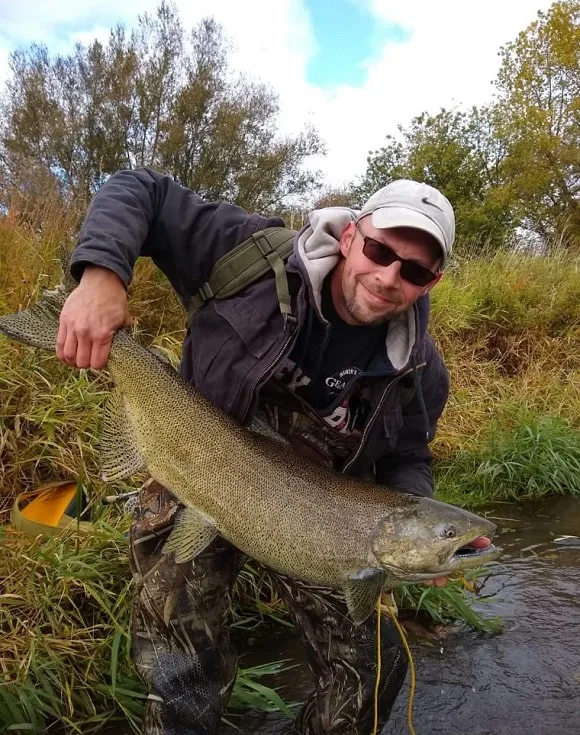
The prime time to fish for salmon in Michigan is from late August through mid-November.
Most king salmon runs will occur in September and October in Michigan, which is when most anglers will target them here.
If you’re after coho salmon, September and October won’t disappoint you either, and as they spawn somewhat later than chinooks, December can often imply some very decent fishing as well.
Of course, it is not impossible to catch a few kings earlier than late August or later than mid-November, but the bulk of the fish will migrate upriver during the months mentioned above.
If pink salmon are your game, the period between mid-August and late September is usually the best in Michigan.
And if you want to fish for Atlantic salmon, the best time of year to do so is summer, typically from June to late August, as Atlantics tend to spawn earlier than all the Pacific salmon types found in Michigan.
Where Is the Best Salmon Fishing in Michigan?
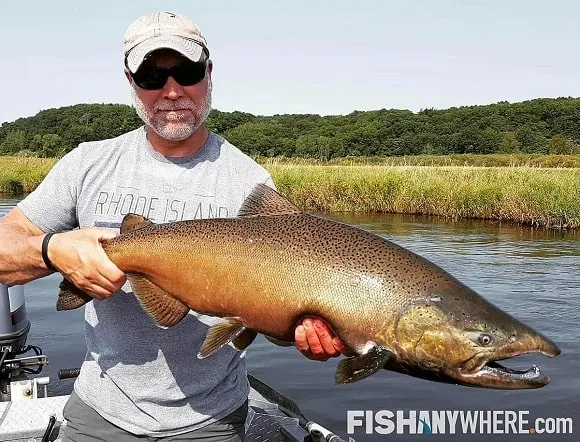
Michigan has got it all; the Great Lakes, numerous tributaries, smaller lakes, and creeks. And practically all of those water bodies are full of fish!
Especially when it comes to salmon and trout, Michigan is undoubtedly one of the country’s very best fishing destinations.
The possibilities are virtually endless!
Naturally, it would be impossible to list all of the state’s salmon waters. There are simply too many of them.
So I have narrowed it down to the seven most productive and popular salmon waters in Michigan.
Manistee River
The Big Manistee and its Tippy Dam are perhaps the most popular and well-known salmon destinations in Michigan.
This beautiful river has an early chinook season, starting as early as late August or early September, allowing anglers to target kings much earlier than on most other rivers in the state.
The Manistee’s chinook runs typically last until early or mid-November, which makes for a very long fishing season.
October and November are also superb months for coho salmon.
The fish make it all the way up to Tippy Dam, and it is here that most anglers will try their luck for one of the river’s many huge king salmon.
Further downstream, other productive spots include Off Fayette Road (in Deward) and the 612, CCC, and Sharon Bridge.
Where Is the Manistee River Located?
Where Is Tippy Dam Located?
Pere Marquette River
Next up on the list of the best salmon rivers in Michigan is the beautiful Pere Marquette.
This scenic river is 64 miles long and has one of the state’s largest chinook runs.
And so, anglers who fish on the PM can often expect plenty of fish, especially during the main seasons.
For king salmon, that would be mid-September to mid or late October.
The main coho runs typically occur between late September and November.
PRO TIP: Drifting salmon eggs on a bobber rig can often produce the most bites on the Pere Marquette. Especially during the early season!
Where Is the Pere Marquette River Located?
Muskegon River
The Muskegon River is another famous salmon and trout destination, and there is a ton of action for both drift boaters and waders.
The Muskegon is more than 200 miles long, but the salmon fishing takes place below Croton Dam in Croton Township.
The main attraction of this river is its king salmon, which migrate up the river in huge runs during the fall.
The best time for kings is between mid-September and mid-November.
The Muskegon also has a few coho runs, but they tend to be pretty small.
Most anglers who fish from the shore or are wading target the stretch between Newaygo and Croton, while boat anglers will fish the entire river from its mouth up to Croton Dam.
PRO TIP: If you’re after a 30lb+ king salmon, the Muskegon River is a very good pick for you!
Where is the Muskegon River Located?
Grand River
If you’re into urban fishing, the Grand River and its Grand Rapids are just the place for you!
The 6th Street Dam in downtown Grand Rapids, in particular, can offer you an unreal salmon fishing experience!
But as this area is located in an urban environment and is well-known among salmon and trout anglers, it can often get very crowded.
Luckily there are plenty of hot spots further downstream as well, and as many of them can be fished from the shore or in waders, the Grand has plenty of easily accessible salmon spots for you!
During the fall, this river can see immense coho and king runs, and both of these salmon types can reach very good sizes here.
Thanks to the abundance of migrating salmon, fishing can be pretty easy here on good days, making the Grand River a solid choice for beginners.
Where Is the Grand River Located?
St. Mary’s River
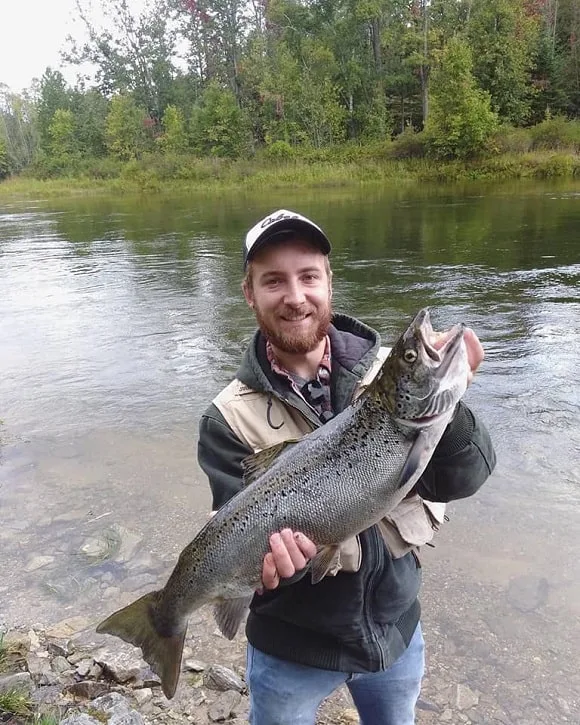
Now this one is a real pearl! St. Mary’s River connects Lake Superior and Lake Huron and is a natural international border separating Michigan and Ontario.
This river is connected to two of the Great Lakes, so there are plenty of salmon species to be found here.
In fact, you can fish for all four types of salmon that are found in Michigan!
Most notably, St. Mary’s has an excellent Atlantic salmon run, as the fish migrate up from Lake Huron to spawn here.
PRO TIP: A hot spot for fall Atlantics are the upper stretches of the river near the Soo locks.
The river also sees significant annual chinook and coho runs and even gets quite a few pink salmon.
St. Mary’s River is another water that has extremely early salmon runs. The chinook, coho, and pink seasons can start as early as late July or early August!
The Atlantics tend to come in even earlier and can be fished with decent success from June through August.
Where Is St. Mary’s River Located?
Rogue River
Next up is Rogue River, which is somewhat of an underdog when it comes to Michigan’s salmon rivers.
The Rogue is one of the biggest tributaries of the Grand River, even though its salmon and trout fisheries only cover about 7 miles.
The salmon fishing on Rogue River takes place between Rockford dam and the confluence with the Grand.
It is its smaller size that makes it such an underrated salmon destination.
Most anglers will stick to the Grand River, not knowing that the Rogue gets a fair share of the Grand’s chinook and coho runs, making it a little-known salmon Mecca!
The Rogue offers you excellent fly fishing opportunities, and king salmon over 20lb are not uncommon.
The best time to target both king and coho is from early September through November.
Where Is the Rogue River Located?
Lake Michigan
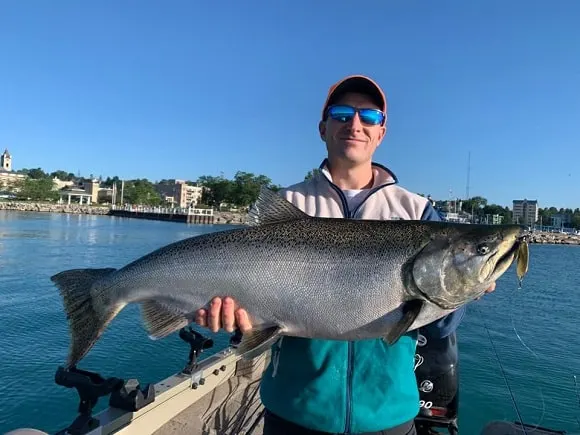
And last but not least, we have the amazing Lake Michigan. Most of the rivers mentioned above are tributaries to this Great Lake; hence, most of the state’s salmon runs originate in its great depths.
Fishing on Lake Michigan has several advantages compared to the rivers!
For one thing, you can target all four salmon types found in Michigan here. Kings and cohos will be the most common catches, but there are also good chances for the occasional pink and Atlantic salmon.
Another great advantage is that Lake Michigan’s salmon season is much longer than the often short river fishing seasons.
While the best time of year for Lake Michigan salmon is undoubtedly summer, typically between May and late August, you can practically target salmon all year long!
Early spring is another great period for targeting salmon on the lake, and so are late summer and early fall, when the fish start their runs.
Where Is Lake Michigan Located?
Best Salmon Fishing Charters in Michigan
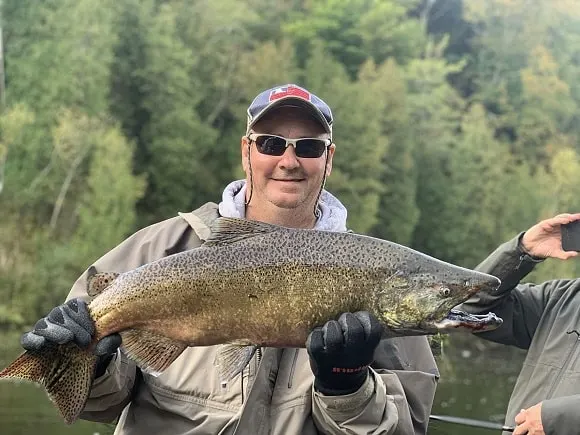
While this article will provide all the basics needed for a successful salmon fishing trip in Michigan, heading out with a knowledgeable fishing guide can often be a wise choice, especially if you’ve never fished the water you’ve chosen.
Michigan is a regular Mecca for salmon anglers, and naturally, the state is also home to plenty of expert fishing guides.
I have checked a bunch of them and read hundreds of customer reviews, as I wanted to make sure to list only the very best of them.
Hiring a guide is an investment, and you’ll want to ensure you get the most value for your money!
Below is a list of some of Michigan’s finest salmon fishing charters. If you’re in need of a guide, be sure to check them out right now:
Fishing Charter | Target Location |
Muskegon River | |
Grand River and Pere Marquette | |
Manistee River | |
Lake Michigan |
Salmon Fishing Regulations for the State of Michigan
Checking the local fishing regulations is essential before any fishing trip. Following the rules means keeping out of trouble and ensuring that you can enjoy your fishing adventure.
Michigan’s Fishing guide will tell you everything you need to know about fishing seasons, possession limits, minimum sizes, and more.
The Michigan DNR has put together a superb page that includes all the information you need for your Michigan salmon adventure.
Via the Michigan.gov fishing section, you can access the state’s up-to-date fishing guide, including the latest species-specific rules and regulations.
The section also provides information about licenses, fishing reports, and a fish stocking database.
PRO TIP: Download the Michigan Hunt and Fish App to access all the information mentioned above even faster!
Do You Need a Fishing License in Michigan?
All residents and non-residents age 17 or older must carry a valid fishing license when fishing in the state of Michigan.
Anglers under the age of 17 are allowed to fish without a license but must follow all state fishing rules and regulations.
Annual licenses in Michigan are always valid from March 1st through March 31st of the following year.
You can find more information about Michigan’s fishing licenses here. You can also find more information on how to buy your fishing license online or in a store on this page.
Can You Fish for Salmon at Night in Michigan?
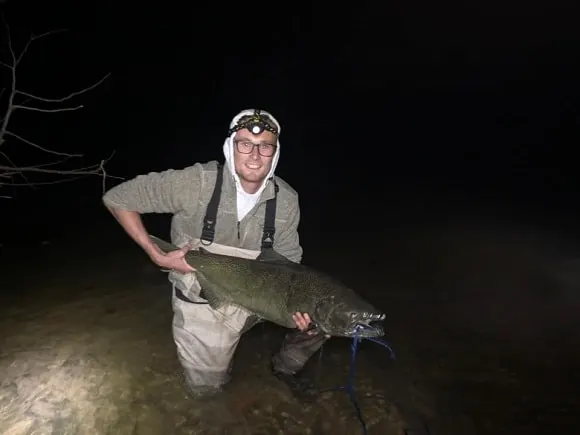
Night fishing is legal in the state of Michigan, and if the bite isn’t on during the daytime, you should definitely try to catch salmon at night!
The hour just after sunset is usually quiet, as the fish seem to adjust to the dark.
They turn on again after that initial hour, and the bite can be on for the entire night!
Try using moonshine spoons or crankbaits with very flashy colors, and you should be able to get bites in the dark.
RELATED READING: What Is the Difference Between Atlantic and Pacific Salmon?
Salmon Fishing Reports for Michigan
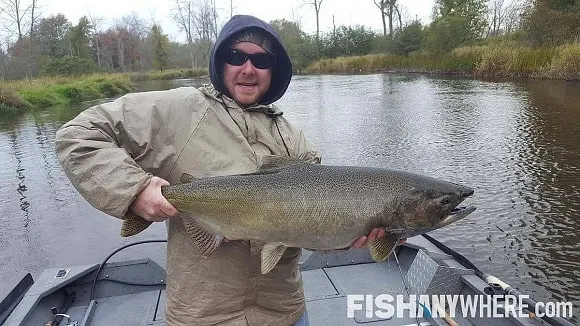
If you don’t live right next to your target river, checking up-to-date fishing reports is the best way of knowing when the bite is on.
That holds especially true for out-of-state anglers. If you drive for several hours to fish for salmon in Michigan, there’d better be salmon in the river when you get there, right?
And the best way to find out if that is so is by checking fishing reports.
By far, the best and most detailed Michigan salmon fishing report is published by the Michigan Department of Natural Resources.
I have seen plenty of fishing reports and DNR sites. Trust me when I tell you that the Michigan DNR’s weekly fishing report is one of the best ones out there!
They literally cover everything:
- lake and river reports from the entire state
- temperature maps
- daily streamflow conditions
- lure and bait tips
- fishing depths
- hot spots
Additionally, you can buy your license and check for fishing regulations on the same site, which is very convenient.
I also found this very detailed fishing report for the Manistee, Pine, and Pere Marquette River by Premiere Angling Guide Service.
That guy clearly knows his game, and fishing reports coming from guides that fish directly at the source are always valuable information!
This fishing report is updated frequently and includes the latest catches and conditions and many helpful tips and tricks on how to fish for salmon in these famous rivers.
How Big Do Salmon Get in Michigan?
Chinook Salmon
The king, or chinook salmon, is the biggest salmon type you can catch in Michigan.
They reach average weights of around 10 to 20lb and maximum weights of approximately 40lb in both the Great Lakes and various river systems connected to lakes.
Atlantic Salmon
Atlantics can be found in the Great Lakes and a few of the bigger river systems in Michigan.
While their average weight is between 8 and 12lb, they can actually grow to fairly good sizes, reaching maximum weights of around 30lb.
Coho Salmon
The average size of Michigan coho salmon is about 8 to 10lb, but specimens between 10 and 20lb are more common than you’d expect, especially in the Great Lakes.
The maximum size of coho salmon in Michigan is 25 to 30lb.
Pink Salmon
Pinks are, by far, the smallest salmon type found in Michigan.
They reach an average size of around 2 to 4lb and have a maximum size of 8lb.
Most of them will be found in Lake Huron and its tribs.
What Is the Biggest Salmon Caught in Michigan?
The current Michigan state record salmon is a huge chinook of 47.86lb that was caught on Lake Michigan in 2021.
Angler Luis Ricardo Hernandez Martinez caught it on a trolled Moonshine spoon.
This massive salmon is not only the biggest one ever caught in the state of Michigan but also the biggest salmon ever caught in all of the Great Lakes.
Imagine catching such a monster in one of Lake Michigan’s tribs during a salmon run. Unreal!
Related Salmon Fishing Articles
- Salmon Fishing in Washington (An Angler’s Guide)
- How Big Do Salmon Get? (Average and Record Sizes)
- Best Steelhead Fishing in Michigan (Everything You Need to Know)
Featured image courtesy of Tyler Friss

